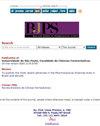Levetiracetam plus Oxcarbazepine Combination Treatment Downregulates Serum Multidrug Resistance Protein 1 Levels and Upregulates Neuropeptide Y Levels in Children with Epilepsy
IF 0.9
4区 医学
Q4 PHARMACOLOGY & PHARMACY
引用次数: 0
Abstract
The aim of the present study was to investigate the usefulness of multidrug resistance protein 1 (MDR1) and neuropeptide Y (NPY) levels in predicting the efficacy of levetiracetam (LEV) plus oxcarbazepine (OXC) treatment administered to children with epilepsy and to determine their prognosis. Overall, 193 children with epilepsy admitted to the hospital were enrolled and randomly divided into two groups according to different treatment methods: group A (n = 106, treated with LEV plus OXC combination) and group B (n = 87, treated with OXC only). After treatment, compared with group B, group A exhibited a remarkably higher total effective rate and a significantly lower total adverse reaction rate. Areas under the curve for MDR1 and NPY for predicting ineffective treatment were 0.867 and 0.834, whereas those for predicting epilepsy recurrence were 0.916 and 0.829, respectively. Electroencephalography abnormalities, intracranial hemorrhage, neonatal convulsion, premature delivery, and MDR1 and NPY levels were independent risk factors for poor prognosis in children with epilepsy. Serum MDR1 and NPY levels exhibited a high predictive value for early epilepsy diagnosis, treatment efficacy assessment, and prognostication in children with epilepsy treated with LEV plus OXC combination.左乙拉西坦联合奥卡西平治疗下调癫痫患儿血清多药耐药蛋白1水平,上调神经肽Y水平
本研究的目的是探讨多药耐药蛋白1 (MDR1)和神经肽Y (NPY)水平在预测左乙拉西坦(LEV)联合奥卡西平(OXC)治疗癫痫患儿的疗效和确定其预后方面的作用。共纳入193例住院癫痫患儿,根据治疗方法的不同随机分为A组(106例,采用LEV + OXC联合治疗)和B组(87例,仅采用OXC治疗)。治疗后,与B组比较,A组总有效率显著高于B组,总不良反应率显著低于B组。预测治疗无效的MDR1和NPY曲线下面积分别为0.867和0.834,预测癫痫复发的MDR1和NPY曲线下面积分别为0.916和0.829。脑电图异常、颅内出血、新生儿惊厥、早产、MDR1和NPY水平是癫痫患儿预后不良的独立危险因素。血清MDR1和NPY水平对LEV + OXC联合治疗的癫痫患儿早期癫痫诊断、疗效评估及预后具有较高的预测价值。
本文章由计算机程序翻译,如有差异,请以英文原文为准。
求助全文
约1分钟内获得全文
求助全文
来源期刊

Brazilian Journal of Pharmaceutical Sciences
PHARMACOLOGY & PHARMACY-
CiteScore
1.40
自引率
0.00%
发文量
165
审稿时长
7.5 months
期刊介绍:
The Brazilian Journal of Pharmaceutical Sciences accepts for publication Original Papers applicable to the fields of Pharmaceutical Sciences; Reviews and Current Comment Articles, which are published under the Scientific Editor and Associate Editors invitation to recognized experts or when they are spontaneously submitted by the authors in the form of abstracts to have their importance evaluated. A critical view of the subject with insertions of results of previous works in the field in relation to the state of art must be included; Short Communications reporting new methods and previews of works on researches of outstanding importance in which originality justify a quick publication. A maximum of 2000 words excluding tables, figures and references is an acceptable limit. One table, one figure and ten references may be added, and Book Reviews of the latest editions of books, prepared by specialists invited by the Scientific Editor and Associate Editors. Thematic Supplements as well as those related to scientific meetings can be published under the Scientific Editor and/or Associate Editors agreement.
 求助内容:
求助内容: 应助结果提醒方式:
应助结果提醒方式:


